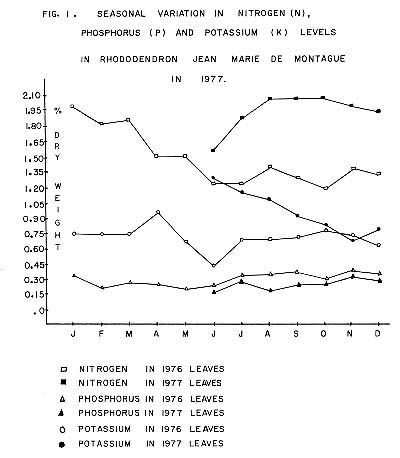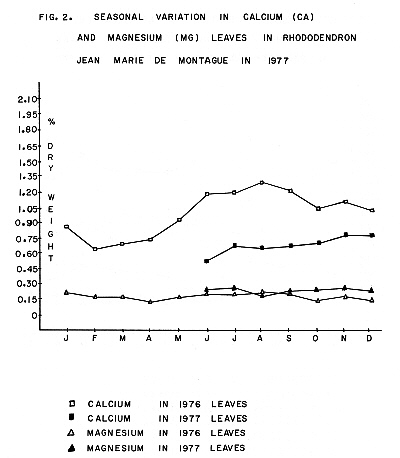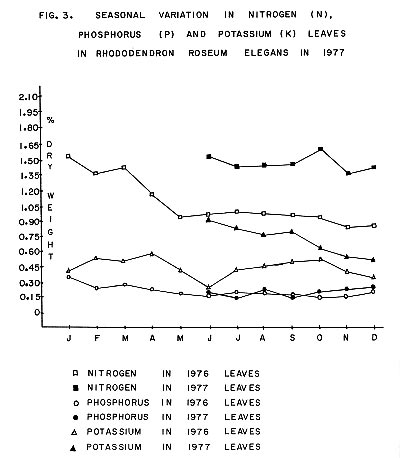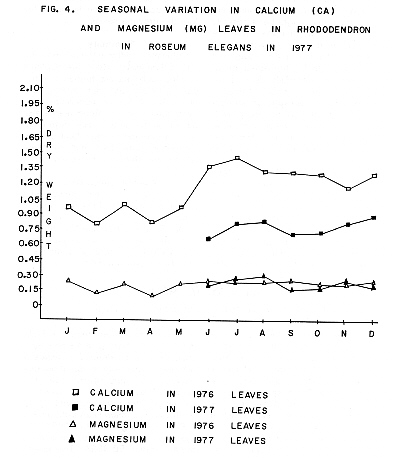QBARS - v32n3 Mineral Content of Rhododendron Foliage
Mineral Content Of Rhododendron Foliage
R. L. Ticknor and J. L. Long
Rhododendron quality (growth, leaf color, and flower bud formation) appeared to be related to the mineral content of the leaves in a leaf analysis survey of six cultivars in 15 nurseries in Oregon and Washington during January 1977. Soil samples were collected at the same time. Differences in the soil values around good and poor plants of each cultivar were found.
Leaf analysis has become a standard practice in the tree fruit industry to determine the fertilizer needs of the trees. Time of sampling and critical leaf mineral levels had to be established before this tool could be used. Leaves are sampled at periods when the mineral levels are not rapidly changing. This time was found to be August for deciduous fruit trees but winter for evergreens such as citrus and English holly. The mineral content of leaves from many good, average and poor orchards were determined to establish standards for good growth and production.
This survey and a year around sampling program were done to establish tentative standards for mineral content and the best time to sample rhododendron leaves.
Methods and Materials
Five popular cultivars - 'Blue Ensign', 'Jean Marie de Montague', 'Roseum Elegans', 'Unique', and 'Vulcan' which growers had observed to have different nutrient requirements were selected for the survey. A sixth cultivar, 'Trilby', was sampled if a nursery was not growing one of these five. Twenty-five to thirty current season's leaves were collected from each cultivar at each nursery in January 1977. A quality estimate on a 1-5 scale for leaf color, plant growth, and flower bud production was done as the samples were being collected. With very few exceptions, the plants in this survey were in the second year of the three year field production cycle. Twelve nurseries were growing plants in the field and three in containers.
A soil tube was used to obtain 6"sample at each nursery. Soil cores were taken near the cultivars being tested or in the containers.
The leaves were washed to remove surface contamination then dried before being ground for chemical analysis. Oregon State University's Horticulture Department laboratory used a Direct Reading Spark Emission Spectroscope to determine the amount of phosphorus (P), potassium (K), calcium (Ca), magnesium (Mg), manganese (Mn), iron (Fe), copper (Cu), boron (B), zinc (Zn), and aluminum (Al) in the leaf tissue. Total nitrogen was determined by the Kjeldahl method.
Year around sampling was done in one nursery with two cultivars, 'Jean Marie de Montague' and 'Roseum Elegans'. Sampling started with the January 1977 sample and continued once a month through December 1977 on the leaves produced in 1976. Starting in June, leaves produced in 1977 were sampled once a month.
|
Table I. Comparison of average foliar nutrient values with those from
good and poor plants sampled in January 1977 at 15 nurseries. |
|||||||||||
|
Variety and
Quality |
Percent Dry Weight | PPM Dry Weight | |||||||||
| N | P | K | Ca | Mg | Mn | Fe | Cu | B | Zn | Al | |
| 'Blue Ensign' | |||||||||||
| Average | 1.79 | 0.26 | 0.60 | 0.99 | 0.22 | 1085 | 197 | 3 | 27 | 37 | 99 |
| Good Plants | 1.65 | 0.29 | 0.56 | 1.06 | 0.22 | 1212 | 117 | 3+ | 43 | 27 | 64 |
| Poor Plants | 1.73 | 0.23 | 0.66 | 0.94 | 0.22 | 979 | 64 | 3- | 28 | 51 | 117 |
| 'Jean Marie' | |||||||||||
| Average | 1.84 | 0.26 | 0.84 | 0.92 | 0.25 | 807 | 182 | 3 | 45 | 33 | 113 |
| Good Plants | 2.07 | 0.29 | 0.81 | 0.93 | 0.27 | 820 | 119 | 3- | 47 | 37 | 71 |
| Poor Plants | 1.72 | 0.23 | 1.02 | 0.75 | 0.27 | 937 | 199 | 5 | 49 | 26 | 144 |
| 'Roseum Elegans' | |||||||||||
| Average | 1.73 | 0.24 | 0.47 | 1.03 | 0.22 | 899 | 117 | 3 | 28 | 24 | 115 |
| Good Plants | 1.90 | 0.26 | 0.41 | 1.03 | 0.19 | 1541 | 93 | 2 | 34 | 21 | 131 |
| Poor Plants | 1.68 | 0.20 | 0.59 | 0.90 | 0.23 | 696 | 59 | 3- | 22 | 22 | 104 |
| 'Trilby' | |||||||||||
| Average | 1.52 | 0.19 | 0.47 | 0.86 | 0.23 | 550 | 178 | 1 | 29 | 23 | 61 |
| Good Plants | 1.66 | 0.21 | 0.44 | 0.83 | 0.22 | 602 | 245 | 1 | 38 | 25 | 20 |
| Poor Plants | 1.30 | 0.14 | 0.53 | 0.91 | 0.31 | 387 | 140 | 1 | 20 | 24 | 89 |
| 'Unique' | |||||||||||
| Average | 1.64 | 0.24 | 0.65 | 0.88 | 0.27 | 624 | 151 | 2 | 37 | 47 | 129 |
| Good Plants | 1.59 | 0.26 | 0.71 | 0.82 | 0.25 | 687 | 138 | 2- | 44 | 35 | 91 |
| Poor Plants | 1.48 | 0.25 | 0.63 | 0.82 | 0.30 | 646 | 187 | 3- | 39 | 47 | 157 |
| 'Vulcan' | |||||||||||
| Average | 1.91 | 0.23 | 0.47 | 1.33 | 0.23 | 1069 | 131 | 3 | 36 | 31 | 106 |
| Good Plants | 1.84 | 0.22 | 0.43 | 1.39 | 0.19 | 1260 | 138 | 3 | 33 | 29 | 106 |
| Poor Plants | 1.78 | 0.18 | 0.62 | 1.15 | 0.27 | 637 | 59 | 2 | 30 | 38 | 66 |
Leaf Analysis Results
Table I shows the average values of each element for all the plants of a cultivar as well as the average values for the four highest and four lowest rated groups of a cultivar. Although there were differences in mineral content between each cultivar, there were also some general trends. Good plants had a higher level of nitrogen (N) than poor plants except for 'Blue Ensign'. Phosphorus (P) levels were also higher in good plants. Potassium (K) values were lower in good plants except for 'Unique'. Calcium (Ca) values in good plants tended to be high in good plants but the ratio of calcium to magnesium (Mg) may be even more important. The better plants had more calcium in relation to magnesium. The highest levels of manganese were associated with the best appearing plants. Boron levels were higher in good than poor plants. No clear trend was seen for the other minor elements.
Two cultivars 'Unique' and 'Vulcan' with reputations for being easily injured by excess fertilizer have contrasting mineral accumulation patterns. This suggests that different elements in excess may be responsible for the foliage burn sometimes seen on these cultivars. In one nursery, the planting of 'Unique' occupied one 40' wide bed and one 20' wide bed at the end of the field. By mistake the same amount of nitrogen fertilizer was applied to both beds. The leaves were badly burned and had a 2.30 percent nitrogen content in the 20' bed but were normal appearing with a 1.77 percent nitrogen content in the 40' bed. Other elements remained about the same.
| Table 2. The Effect of Soil Composition on Rhododendron Plant Quality Found in 1977 Survey | ||||||||||||
| Sample | 'Blue Ensign' | 'Jean Marie' | 'Roseum Elegans' | 'Trilby' | 'Unique' | 'Vulcan' | ||||||
| Description | G | P | G | P | G | P | G | P | G | P | G | P |
| Soil pH | 5.2 | 5.0 | 5.3 | 5.0 | 5.4 | 5.6 | 5.0 | 5.0 | 5.4 | 4.9 | 5.4 | 5.3 |
| Buffer pH | 6.8 | 6.5 | 6.7 | 6.6 | 6.7 | 6.9 | 6.5 | 6.5 | 6.7 | 6.5 | 6.8 | 6.7 |
| Soluble Salts | .43 | 0.2 | 0.18 | 0.25 | 0.48 | 0.25 | 0.2 | 0.18 | 0.35 | 0.24 | 0.43 | 0.27 |
|
Available
Phosphorus |
130.0 | 73.0 | 144.0 | 99.0 | 160.0 | 89.0 | 157.0 | 94.0 | 146.0 | 93.0 | 145.0 | 80.0 |
|
Exchangeable
Potassium |
205.0 | 107.0 | 213.0 | 153.0 | 250.0 | 197.0 | 183.0 | 145.0 | 224.0 | 158.0 | 245.0 | 137.0 |
|
Exchangeable
Magnesium |
225.0 | 80.0 | 145.0 | 180.0 | 247.0 | 233.0 | 127.0 | 110.0 | 208.0 | 164.0 | 213.0 | 220.0 |
|
Exchangeable
Calcium |
1325.0 | 733.0 | 1150.0 | 625.0 | 1033.0 | 1000.0 | 1000.0 | 850.0 | 1240.0 | 660.0 | 1300.0 | 900.0 |
|
Exchangeable
Sodium |
80.0 | 47.0 | 77.0 | 42.0 | 76.0 | 52.0 | 52.0 | 58.0 | 78.0 | 50.0 | 71.0 | 58.0 |
| CEC | 12.7 | 10.8 | 11.1 | 10.9 | 11.4 | 9.7 | 13.1 | 11.8 | 12.4 | 11.1 | 12.5 | 10.9 |
|
% H Base
Saturation |
26.8 | 54.1 | 29.7 | 47.7 | 28.8 | 20.3 | 49.7 | 47.5 | 29.4 | 47.3 | 26.9 | 34.4 |
|
% K Base
Saturation |
4.2 | 2.5 | 4.9 | 3.8 | 5.7 | 5.1 | 3.3 | 3.2 | 2.5 | 4.1 | 5.1 | 3.2 |
|
% Mg Base
Saturation |
14.6 | 5.9 | 11.0 | 15.3 | 17.2 | 20.3 | 7.8 | 7.8 | 13.9 | 13.6 | 13.6 | 18.4 |
|
% Ca Base
Saturation |
51.5 | 35.5 | 51.3 | 31.1 | 45.1 | 51.6 | 37.3 | 39.2 | 49.2 | 32.6 | 51.8 | 44.0 |
|
% Na Base
Saturation |
2.7 | 1.8 | 2.9 | 1.8 | 3.0 | 2.4 | 1.7 | 2.1 | 2.8 | 2.2 | 2.4 | 2.5 |
|
Available
Zinc |
2.1 | 6.0 | 1.8 | 2.4 | 2.3 | 3.0 | 3.2 | 4.1 | 3.2 | 3.3 | 3.2 | 4.3 |
|
Available
Manganese |
37.6 | 26.6 | 52.0 | 44.6 | 53.4 | 46.2 | 50.8 | 28.3 | 36.2 | 35.8 | 37.5 | 24.8 |
|
Available
Copper |
1.2 | 1.8 | 0.8 | 0.6 | 0.9 | 0.7 | 1.0 | 0.8 | 1.1 | 0.6 | 1.2 | 0.7 |
|
Available
Iron |
53.9 | 62.9 | 62.5 | 56.4 | 60.3 | 37.5 | 76.2 | 71.1 | 63.2 | 55.5 | 51.9 | |
| G = Good Plants | ||||||||||||
| P = Poor Plants | ||||||||||||
| (Available and exchangeable elements are expressed in parts per million.) | ||||||||||||
Soil Test Results
When the soil tests from around the four highest and four lowest rated groups of a cultivar were compared (Table 2), several differences were found. The amounts in parts per million (ppm) of available calcium, phosphorus, potassium, and manganese were higher around the good plants. The sodium level was also higher around good plants for all cultivars except 'Trilby' but this is probably a by-product of maintaining high levels of the other elements rather than a need of the rhododendrons. Copper levels around good plants were higher around good plants except 'Blue Ensign'. Apparently 1 ppm copper in soil will supply enough for rhododendrons. Zinc was the one element showing a consistent negative response to a higher concentration. Probably 2 p. p.m. in the soil is sufficient for rhododendrons.
The CEC (cation exchange capacity) which is a measure of the soil's ability to hold fertilizer elements was higher in the nurseries with good plants. The base saturation indicates how much of this capacity is taken up by ammonium, calcium, hydrogen, magnesium, potassium, sodium, and other basic elements. If the soil is low in fertility much of its capacity is taken up by hydrogen (H) rather than useful elements such as calcium, magnesium and potassium.
For most cultivars in this survey, the base saturation for calcium was 50% of the CEC around the better plants. Magnesium was about 1214% of the CEC around the good plants. Potassium had a 3-4% base saturation around the better plants.

|

|

|

|
Year Around Survey Results
Leaf mineral content varied with leaf age in rhododendrons as it does in other plants, as shown on graphs 1-4. Both 'Jean Marie' and 'Roseum Elegans' showed a marked decline of nitrogen in the one year old leaves starting in April. Phosphorus also declined after being at the highest level during the winter period with 'Roseum Elegans'. In contrast phosphorus varied from month to month in 'Jean Marie' but did not show seasonal trends. Potassium was highest in the new leaves declining to relatively stable levels by December. There was a sharp reduction in potassium level in June in both cultivars but the level recovered. June was also the time when percentage of calcium increased in both cultivars. Since these mineral nutrient values are on a percent dry weight basis possibly movement of carbohydrates from the old leaves to the new growth caused a weight reduction of the leaves and was responsible for the apparent increase with the immobile element calcium. Some more mobile elements such as nitrogen, phosphorus, and potassium may move to the new growth thus do not show a percent increase as the leaf weight drops. Other elements remained stable in the year old leaves.
Leaves were sampled on the 1977 growth when they reached mature size in June. Only three elements aluminum, calcium and potassium had similar changes for both cultivars. Aluminum increased as the season progressed while potassium decreased. Calcium was lowest in June. Leaf mineral content was relatively stable between September through January. This would give a long time period for sampling. Results of chemical analysis done during this period could be back from the laboratory in time to apply corrective fertilizes before the growing season.
Summary
Cultivars do differ in the mineral content of their leaves. Good quality plants of most cultivars are higher in nitrogen, phosphorus, manganese, and boron but lower in potassium than poor quality plants. Good plants also have more calcium in relation to magnesium than poor plants. Leaf mineral content is quite stable between September and the end of January.
Acknowledgements
The support of each grower who paid the laboratory fees for five leaf samples from his nursery and of the O. M. Scott Co. who paid for the soil tests and for extra leaf samples from plants showing nutritional problems is gratefully acknowledged.
